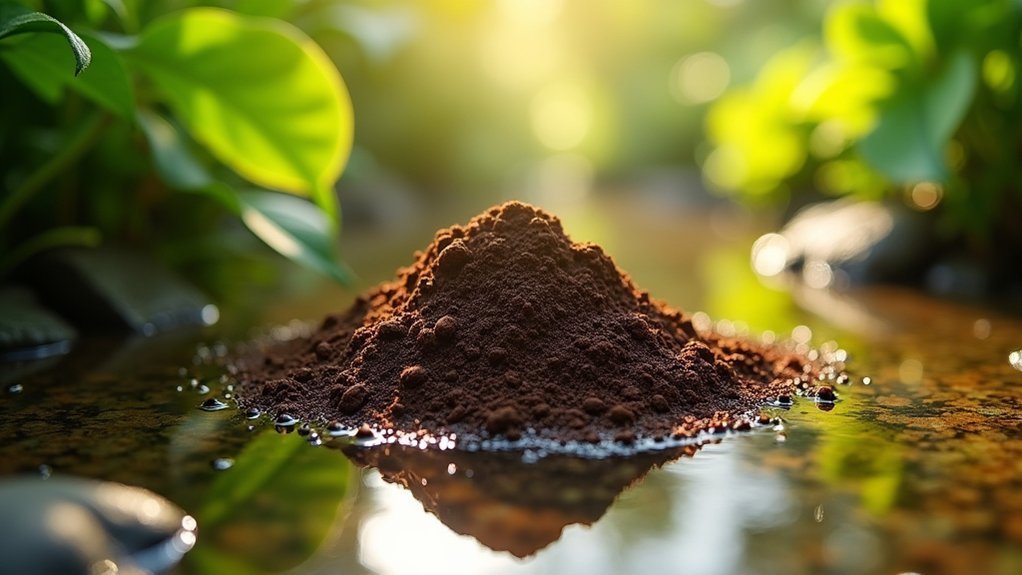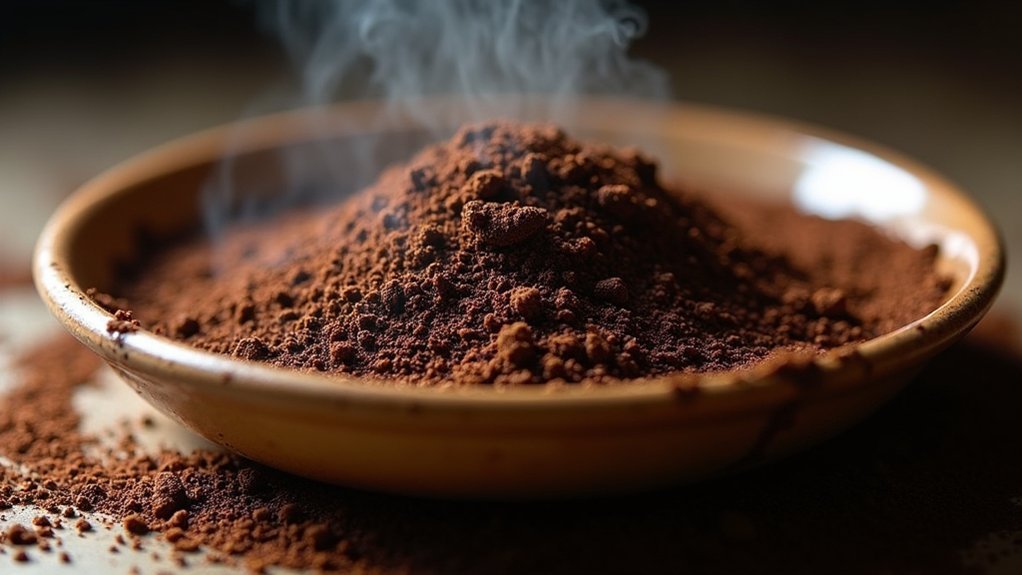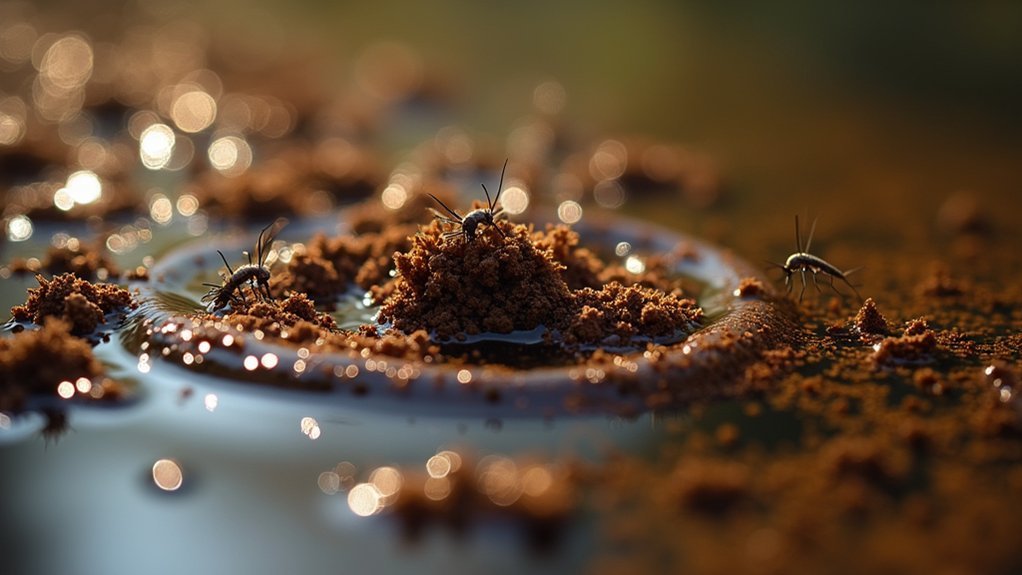Coffee grounds effectively kill mosquito larvae when added to standing water. The caffeine, tannins, and other compounds disrupt the larvae’s nervous system and reduce oxygen levels, preventing them from maturing. Simply sprinkle 3 tablespoons of dried used coffee grounds per cup of standing water in bird baths or plant saucers. Apply bi-weekly during warm months for best results. This eco-friendly method offers a chemical-free way to break the mosquito lifecycle while you enjoy your morning brew.
6 Second-Level Headings for “Coffee Grounds Kill Mosquito Larvae Effectively”

While searching for natural mosquito control methods, you’ll find coffee grounds offer a remarkably effective solution for eliminating mosquito larvae in standing water.
Coffee grounds provide a natural, powerful way to eliminate mosquito larvae in standing water.
This eco-friendly approach works by creating a suffocating barrier that prevents larvae from breathing at the water’s surface.
For best results, simply sprinkle about 3 tablespoons of coffee grounds per cup of standing water.
The application method couldn’t be simpler—just distribute the grounds evenly across the water’s surface where mosquitoes breed.
By preventing growth and development of larvae, you’re stopping mosquitoes before they can mature.
This safe alternative to chemical treatments won’t harm pets or wildlife, making it ideal for garden ponds and rainwater collection areas where you’re concerned about environmental impact.
The Science Behind Coffee Grounds as Mosquito Larvicide
Coffee grounds kill mosquito larvae through caffeine and other compounds that disrupt the insects’ nervous systems when dissolved in water.
You’ll find these natural chemicals work at concentrations of approximately three tablespoons per cup of standing water, creating a toxic environment that prevents larvae from developing properly.
The grounds’ effectiveness comes from both their chemical properties and their physical presence, which reduces oxygen levels in the water and creates an inhospitable environment for mosquito development.
Biochemical Action Mechanism
The fascinating science behind coffee grounds’ effectiveness as a mosquito larvicide lies in their complex biochemical properties. When you add coffee grounds to standing water, they release compounds that work against mosquito larvae in multiple ways.
- Caffeine actively disrupts the larvae’s nervous system, inhibiting development and preventing successful hatching in the aquatic environment.
- The compounds in coffee grounds reduce water’s surface tension, making it impossible for larvae to maintain proper breathing positions, effectively suffocating them.
- Unlike chemical larvicides, coffee grounds provide an eco-friendly alternative that targets mosquito larvae specifically without harming beneficial aquatic life in the same water sources.
This natural approach can eliminate up to 100% of mosquito larvae when applied at the recommended ratio of 3 tablespoons per cup of standing water.
Compounds That Target Larvae
Research into exactly which compounds create coffee grounds’ larvicidal effects has revealed a complex chemical arsenal that specifically targets mosquito larvae. When you apply coffee grounds to standing water, you’re introducing several bioactive substances that disrupt the mosquito lifecycle.
| Compound | Effect on Mosquito Larvae |
|---|---|
| Caffeine | Toxic to larvae, causes increased mortality |
| Tannins | Alter water’s chemical composition |
| Phenolic acids | Inhibit larval development |
| Nitrogenous compounds | Reduce hatching rate of eggs |
| Essential oils | Create unfavorable environment |
These compounds work synergistically to control mosquito populations by preventing larvae from maturing into adults. You’ll find that just 3 tablespoons of coffee grounds per cup of standing water can greatly impact larval survival, offering an eco-friendly solution to mosquito management.
Lethal Concentration Rates
Multiple scientific studies have established specific concentration rates at which coffee grounds become lethal to mosquito larvae.
You’ll find that even low concentrations of 1-2% coffee grounds mixed into standing water can dramatically reduce larval development, primarily due to caffeine’s toxic effects on the young mosquitoes.
- Optimal application rate: 3 tablespoons of coffee grounds per cup of water creates an effective larvicide concentration
- Minimum effective dose: 1-2% concentration considerably disrupts larval development and increases mortality rates
- Enhanced effectiveness: Combining coffee grounds with regular monitoring of standing water sources creates a more thorough pest management approach
The caffeine compounds in coffee grounds interfere with larval development systems, preventing them from maturing into adult mosquitoes.
This natural solution offers an accessible and eco-friendly alternative to chemical larvicides.
How to Prepare Coffee Grounds for Larvae Control
While many people discard used coffee grounds without a second thought, these household leftovers can become powerful tools in your fight against mosquito larvae.
To prepare coffee grounds effectively, collect your used grounds and make sure they’re completely dry before application.
Dry your collected coffee grounds thoroughly before use for optimal mosquito-fighting effectiveness.
For best results, mix about 3 tablespoons of dried coffee grounds per cup of standing water where mosquito larvae might develop. Sprinkle these grounds around bird baths, plant saucers, and other areas with standing water to disrupt larvae and prevent mosquito reproduction.
Remember to avoid adding coffee grounds to ponds or water sources that animals depend on, as this can harm aquatic ecosystems.
To maintain effectiveness, check treated areas every few days and replenish the coffee grounds as needed to consistently control mosquito populations.
Application Methods for Treating Standing Water

You’ll find two effective ways to apply coffee grounds for mosquito control in standing water.
For the direct sprinkle method, simply scatter three tablespoons of dry grounds across the water’s surface where you’ve spotted larvae activity.
Alternatively, you can create a steeped grounds solution by soaking coffee grounds in water overnight before straining and pouring the resulting brown liquid into breeding sites.
Direct Sprinkle Method
Three simple tablespoons of coffee grounds per cup of standing water can effectively eliminate mosquito larvae through the direct sprinkle method. This approach creates a surface barrier that suffocates the larvae by preventing them from reaching air, disrupting their lifecycle before they can mature into biting adults.
For maximum effectiveness:
- Target small, stagnant water sources where mosquitoes breed – bird baths, plant saucers, and puddles are ideal candidates.
- Apply fresh coffee grounds directly to the water’s surface, ensuring even distribution.
- Reapply after rain or when you notice the grounds have settled.
Remember not to treat water sources that beneficial species depend on.
The direct sprinkle method is particularly effective in controlled environments where you can monitor the treatment’s impact on mosquito populations.
Steeped Grounds Solution
Creating a steeped grounds solution offers a more concentrated approach to eliminating mosquito larvae than the direct sprinkle method. To prepare this effective mixture, combine 3 tablespoons of used coffee grounds with 1 cup of standing water and stir thoroughly. This concoction works by disrupting the water’s surface tension, making it impossible for mosquito larvae to breathe.
You’ll want to apply this steeped solution to areas of stagnant water around your property—bird baths, plant saucers, and rain barrels are perfect targets.
For maximum effectiveness, replace your application every few days, especially after rainfall, to maintain its larvicidal properties. Remember to use this treatment only in non-potable standing water to avoid harming beneficial wildlife.
With consistent application, you’ll greatly reduce mosquito populations while repurposing your used coffee grounds.
Optimal Timing and Frequency for Treatment
Success in controlling mosquito populations with coffee grounds relies on proper timing and consistent application. You’ll need to apply the treatment at least once every two weeks, focusing particularly on standing water sources where mosquito larvae thrive. Use about 3 tablespoons of coffee grounds per cup of water for maximum effectiveness.
Eliminate mosquito larvae by applying coffee grounds bi-weekly to standing water – 3 tablespoons per cup for optimal results.
For best results:
- Apply during warmer months when larvae are most active.
- Check and replenish treatments after heavy rainfall.
- Target the early stages of mosquito development to effectively disrupt the lifecycle.
Remember to monitor treated areas regularly to prevent infestations from recurring. This consistent attention guarantees the coffee grounds maintain their effectiveness against mosquito larvae.
Adapting your application timing based on weather conditions and mosquito activity in your area will greatly improve your control efforts.
Combining Coffee Grounds With Other Natural Control Methods

While coffee grounds alone can be effective against mosquito larvae, you’ll achieve maximum protection by integrating them with complementary natural methods.
Start by eliminating standing water around your property, as this directly reduces breeding sites where mosquitoes lay eggs.
Enhance your repellent strategies by pairing coffee grounds with essential oils like citronella or eucalyptus. Their complementary scents create a powerful deterrent against mosquito activity.
Try sprinkling grounds around your outdoor living spaces and then setting up traditional mosquito traps nearby for a multi-layered defense.
Burning bay leaves alongside your coffee ground treatment can amplify the repellent effect through their combined strong aromas.
For long-term prevention of infestations, establish a regular schedule of applying coffee grounds while continuously monitoring water sources to disrupt larvae development.
Frequently Asked Questions
Do Coffee Grounds Kill Mosquito Larvae?
Yes, coffee grounds do kill mosquito larvae effectively. They suffocate the larvae by creating a barrier on water’s surface. You’ll need about 3 tablespoons per cup of standing water for best results.
What Is the Most Effective Way to Kill Mosquito Larvae?
You’ll find BTI dunks most effective for killing mosquito larvae in standing water. They’re specifically designed to target larvae without harming other wildlife. Eliminating standing water sources entirely offers the best prevention strategy.
What Is the Most Effective Homemade Mosquito Repellent?
Mix 10-15 drops of eucalyptus, citronella, or lavender essential oils with 2 tablespoons of coconut oil. You’ll find this combination creates the most effective homemade mosquito repellent for your exposed skin.
Do Used Coffee Grounds Keep Bugs Away?
Yes, used coffee grounds keep bugs away effectively. You’ll find they repel mosquitoes, ants, and other pests with their strong aroma. Just sprinkle them around outdoor areas and reapply after rain for best results.
In Summary
You’ve now discovered an eco-friendly weapon against mosquitoes right in your kitchen. Coffee grounds offer an effective, chemical-free solution that’s accessible to everyone. By incorporating this simple technique into your mosquito management strategy, you’ll reduce larvae populations while recycling waste. Don’t wait for mosquito season to strike—start collecting your grounds today and take control of these disease-carrying pests naturally.





Leave a Reply